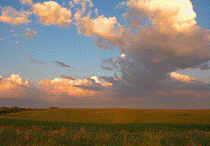
Proceedings of the North American Prairie Conferences
Date of this Version
1989
Document Type
Article
Abstract
Ten eastern Nebraska tallgrass prairie remnants were evaluated up to four times during the 1979 growing season to assess vegetative composition and the effects of mowing, topographic and size differences, and season of evaluation. Frequent mowing resulted in a reduced canopy cover of some species, such as big bluestem (Andropogon gerardii Vitman) (21% lower with frequent mowing), but increased cover of others, particularly the introduced species smooth brome (Bromus inermis Leyss. subsp. inermis) (35% higher cover with frequent mowing). In addition, frequent mowing resulted in a higher proportion of disturbance species. Comparing the time of mowing, canopy cover of warm-season species averaged 54% higher and cool-season species 26% lower with early summer mowing. Individual species' cover also varied by topoedaphic setting; total plant cover, grass cover, and forb cover were lowest on hilltops and south-facing slopes. Additionally, canopy cover of individual species varied throughout the growing season with total plant cover and the total number of species highest in the August evaluation. A significant, positive correlation (P = 0.05, r =0.44) was found between remnant prairie size and the number of species.


Comments
Published in Prairie Pioneers: Ecology, History and Culture: Proceedings of the Eleventh North American Prairie Conference, August 7-11, 1988, Lincoln, Nebraska (Lincoln, NE 1989).